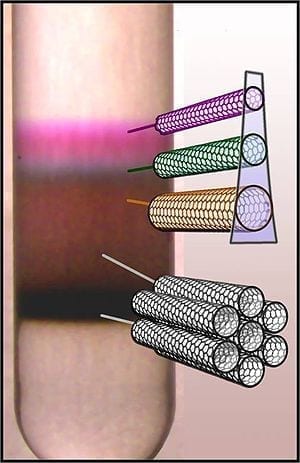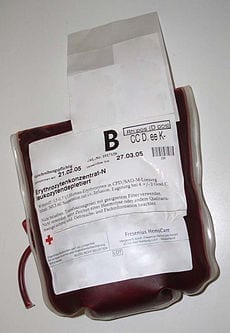“It’s a rudimentary demonstration that carbon nanotubes can be used to build a universal computer”
A group of Stanford researchers has moved a step closer to answering the question of what happens when silicon, the standard material in today’s microelectronic circuits, reaches its fundamental limits for use in increasingly small transistors.
In a paper in the journal Nature on Wednesday, the researchers reported that they had successfully built a working computer — albeit an extremely simple one — entirely from transistors fashioned from carbon nanotubes. The nanotubes, which are cylinder-shaped molecules, have long held the promise of allowing smaller, faster and lower-powered computing, though they have proved difficult to work with.
The Stanford Robust Systems Group, however, has made significant progress in the last 18 months, advancing from building individual carbon nanotube transistors to simple electronic circuits made by interconnecting the transistors, and this week to a complete computer made from an ensemble of just 142 low-power transistors.
While Stanford’s prototype computer is assembled from transistors that are gargantuan by industry standards — one micron vs. 22 nanometers — it is what computer scientists refer to as a “Turing complete” machine, meaning that it is capable of performing any computation, given enough time.
“It can run two programs concurrently, a counting program and a sorting program,” said H.S. Philip Wong, a Stanford University electrical engineer, and one of the leaders of the group. “We’ve spent a tremendous amount of time on this; in fact we’ve spent two generations of students on this.”
The computer is based on a subset of 20 of the instructions used by the commercial MIPS microprocessor, which itself was designed by a group of Stanford researchers led by Stanford’s current president, John Hennessy, during the 1980s.
“I think this is a really nice piece of work,” said Supratik Guha, director of physical sciences at I.B.M.’s Thomas J. Watson Research Center. “It’s a rudimentary demonstration that carbon nanotubes can be used to build a universal computer, or a Turing-complete machine. This is not the most efficient computer, but that wasn’t the point. It’s one of the first steps.”
The Latest Bing News on:
Carbon Nanotube Computer
- A new roadmap to close the carbon cycleon May 1, 2024 at 10:21 am
A major approach to achieving net-zero carbon emissions relies on converting various parts of the economy, such as personal vehicles and heating, to run via electricity generated from renewable ...
- The science of 3 Body Problem: what’s fact and what’s fiction?on April 29, 2024 at 5:00 pm
Nature spoke to the sci-fi program’s adviser and two other researchers about the portrayal of PhD scientists and their technologies.
- A Civil Engineering Renaissanceon April 29, 2024 at 1:22 pm
Civil engineering is coming back into vogue in untraditional ways for students looking to solve global challenges ...
- Pro AV holding steady against renewed supply chain fearson April 26, 2024 at 3:14 am
The crisis in the Middle East has compounded a precarious international situation, but lessons learned during the pandemic have helped to minimise the impact on pro AV, writes Ken Dunn ...
- Single-walled carbon nanotubes doped with 'nitrogen' enhance the performance of secondary battery anodeon April 24, 2024 at 9:27 am
Researchers have developed a new manufacturing technique for "silicon/nitrogen-doped carbon composite anode materials." These materials aim to enhance the capacity and stability of lithium-ion battery ...
- Carbon-Based Tiny Robots Could Revolutionize Various Industrieson April 23, 2024 at 9:17 pm
In explaining his research, the professor in the Department of Mechanical Engineering alludes to the 1966 science-fiction film Fantastic Voyage, about a submarine vessel and its crew shrunk to microsc ...
- Scientists stencil-paint carbon nanotube components for flexible transparent electronicson April 23, 2024 at 9:23 am
Researchers from Skoltech, MIPT, and elsewhere have found a fast and inexpensive way to create geometric patterns in carbon nanotube films. The resulting films turned out to have superior properties ...
- Look uses carbon nanotubes to keep its brand new climbing bike as feathery as possibleon April 23, 2024 at 6:24 am
While the round profiles admit defeat on the aero battlefield, they do help to save weight. The tube profiles, along with the addition of carbon nanotubes (CNTs), which allegedly make the layup ...
- How to ensure readiness of next-generation defense technology: Solving the issue of massive heat.on April 22, 2024 at 7:33 am
High-performance systems generate tremendous amounts of heat that can compromise missions and make high-tech systems less effective in tactical environments. But there is a solution to this modern-age ...
- The Chemistry of Colors: Unveiling the Science Behind Pigments in Arton April 19, 2024 at 8:49 am
Color has a profound impact on our lives, influencing our emotions, creating a unique atmosphere, and sparking creativity.
The Latest Google Headlines on:
Carbon Nanotube Computer
[google_news title=”” keyword=”Carbon Nanotube Computer” num_posts=”10″ blurb_length=”0″ show_thumb=”left”]
The Latest Bing News on:
Carbon nanotube transistors
- Single-walled carbon nanotubes doped with 'nitrogen' enhance the performance of secondary battery anodeon April 24, 2024 at 9:27 am
Researchers have developed a new manufacturing technique for "silicon/nitrogen-doped carbon composite anode materials." These materials aim to enhance the capacity and stability of lithium-ion battery ...
- Carbon Nanotubes Market Size, Opportunities, Share, Growth, Regional Trends, Key Segments, Graph and Forecast to 2028on April 23, 2024 at 10:35 am
Carbon Nanotubes Market by Type (Single Walled & Multi Walled), End Use Industry (Electronics & Semiconductors, Chemical Materials & Polymers, Structural Composites, Energy & Storage, Medical), Method ...
- Scientists stencil-paint carbon nanotube components for flexible transparent electronicson April 23, 2024 at 9:23 am
Researchers from Skoltech, MIPT, and elsewhere have found a fast and inexpensive way to create geometric patterns in carbon nanotube films. The resulting films turned out to have superior properties ...
- New carbon nanotube transistor enhances sensitivity and resolution of molecule glasseson March 29, 2024 at 9:35 am
More information: Yoonhee Lee et al, Carbon-nanotube field-effect transistors for resolving single-molecule aptamer–ligand binding kinetics, Nature Nanotechnology (2024). DOI: 10.1038/s41565-023 ...
- The emergence of molecule glasses capable of unveiling the mysteries of life marks the beginning of a new era in bioscienceon March 27, 2024 at 5:01 pm
developed a carbon nanotube (CNT) transistor for molecule glasses that facilitate detailed examination of molecular interactions. This innovative technology is poised to open a fresh research ...
- The Future of Electronics is Here: How Georgia Tech’s Innovative Graphene Chip Technology Transforms the Fieldon March 7, 2024 at 1:58 am
This results in transistors that can function at terahertz ... but in principle this technology is very similar to semiconducting carbon-nanotube technology which has not been successful after ...
- Carbon Nanotube and Graphene Device Physicson November 21, 2023 at 2:18 pm
Giovanni De Micheli, EPFL "Excellent book covering all aspects of carbon nanotube devices from basic quantum physics in solids over material and device physics to applications including interconnects, ...
- Carbon Nanotube and Graphene Device Physicson June 17, 2023 at 4:50 pm
Additional topics covered include nanotube transistors and interconnects, and the basic physics of graphene. Problem sets at the end of every chapter allow readers to test their knowledge of the ...
- Research & Publicationson September 6, 2022 at 8:58 am
The book consists of eight chapters covering topics on carbon nanotube and graphene transistors, interconnects, flexible sensors, and energy conversion/storage devices, contributed by experts in the ...
- Nanotube inks make their markon April 6, 2019 at 4:05 am
Figure 1: The conductivity of a metallic carbon nanotube is suppressed significantly ... might extend well beyond the field-effect transistors reported by the DuPont–Cornell team.
The Latest Google Headlines on:
Carbon nanotube transistors
[google_news title=”” keyword=”carbon nanotube transistors” num_posts=”10″ blurb_length=”0″ show_thumb=”left”]










